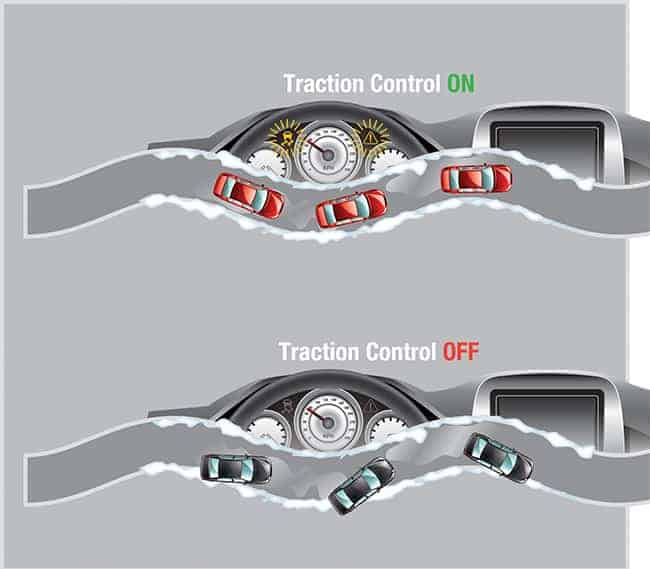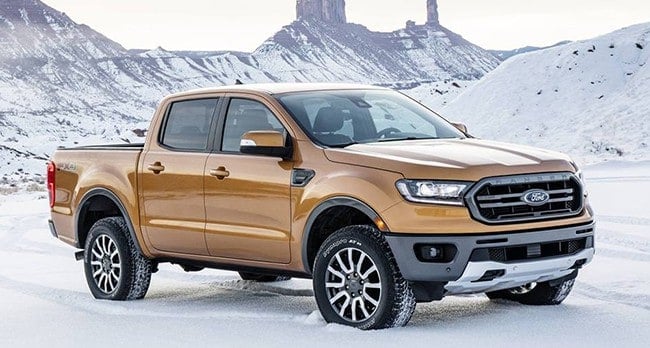Do You Know When to Use Traction Control?

When you’re researching a car, pickup truck, SUV or any vehicle these days you’ll probably see traction control listed as one of its standard safety features, but do you know when to use traction control, do you know what it is, and do you know that it can be turned off?
What exactly is traction control?
Traction control is an invaluable system that uses a vehicle’s anti-lock braking system (ABS) sensors to work out if a wheel or wheels are slipping. If the system decides any wheel is going quicker than the others it will automatically apply the brake to the wheel that’s going faster until traction is regained and the system recognizes that all the wheels are turning at the same speed again. Basically, traction control is an electronic system that helps a driver to accelerate in a controlled manner.
Before these electronic traction control systems were introduced there was a more primitive form of traction control fitted to some vehicles, which was a limited-slip differential, or Positraction, as it was sometimes referred to.
These systems mechanically transferred power to the rear wheel that had the most traction on the rear axle, and they would often be employed on powerful rear-drive cars. This would help to limit wheel spin, but it couldn’t eliminate it completely. Some front and rear-drive vehicles still employ limited-slip differentials, but they now tend to work in conjunction with an electronic traction control system.
Modern traction control systems are not always limited to braking the wheels as that’s not enough to prevent wheel spin in some cases, so engine braking is also used to make some of the systems we have today so effective.
Although traction control can reduce or even eliminate wheel spin, what it won’t do is stop a vehicle from getting stuck in the snow, sand, or mud. Some people mistakenly think the system will do this, but they are mistaking increasing traction for controlling it. Traction control makes the most of what traction is available, but it can’t create traction when there isn’t any.
When is traction control useful?
The most obvious time traction control is useful to have on a vehicle is when you’re driving on a slippery surface such as a wet road or when there’s snow or ice around. However, traction control will also prevent wheelspin under acceleration on a dry road if too much power is applied too quickly.
If you have a car with masses of horsepower and you put your foot straight to the floor, without traction control you’d get wheel spin and potentially damage your tires. In some cases though, a driver might not want traction control to operate in that way, and that’s why there’s often an on/off button for traction control.
You’ll also be pleased to have traction control if you are on an uneven surface like a poorly maintained road or if you are trying to accelerate up a hill with a surface that’s less than ideal.
Perhaps one of the biggest problems with traction control – like a number of modern safety features – is that it can lead to complacency with drivers who don’t properly understand how it works, what it’s meant to do, or its limitations.
Even with ABS, traction control, automatic braking, and other modern safety features on a vehicle, the driver still has to drive within the limitations of the vehicle, the conditions, and their ability.
Why would you turn traction control off?

I would suggest that most of the time, the vast majority of drivers should never really reach for the traction control button to turn it off. However, there are times when drivers who understand it and know what it can and can’t do, might want to operate without assistance from traction control.
The most common occasion when someone might want to turn off traction control is when a vehicle is stuck in the mud, snow, ice, or something else that’s making it difficult to dislodge because having the traction control engaged could be counter-productive.
If you are driving on pavements that are dry, clean, and well-maintained it’s perfectly fine to have the traction control off, but that means you won’t have it if you come across something unexpected like a spillage. Having the system off can deliver measurable improvements in fuel economy and it can also slightly reduce tire wear, but these benefits are vastly outweighed by the increased safety risk.
It can also be desirable to turn traction control off if you are driving a racing car, but even then it’s not a hard and fast rule. A lot of the time, if a car is skidding on a track it’s probably going to record a slower time than if it was staying glued to the tarmac as much as possible, and traction control helps a car to stay planted to the track as much as possible.
On other occasions, a driver might want to induce a power slide, and traction control would make it almost impossible to achieve. The best advice I could give if you are interested in getting into racing is to learn your craft in a relatively low-powered car without traction control on at first to learn how to properly handle a car on the track. Then you can learn when traction control could be a help and when it can be a disadvantage.
Traction control and four-wheel-drive
If you have a four-wheel-drive vehicle there may be times when you want to turn off the traction control. Some manufacturers state in owners’ manuals that drivers of 4×4 vehicles should turn traction control off when going up a steep hill if it’s sandy, icy or snow-covered. This is because you might want the wheels to spin to some degree and not limit engine power.
In such conditions, the brakes could overheat if traction control was left on as they would be constantly applied and disengaged by the traction control system as the vehicle tries to get up the slippery hill. To be honest, though, we’re talking about really extreme conditions here and most drivers are unlikely to come across a time when they really do need to turn the traction control system off on their 4×4.

Verdict
I have found myself in extreme weather in a serious 4×4 and I’ve had to disengage the traction control to make headway, but it was extreme weather and only on a single occasion. For every other moment of my almost 35 years of driving there has been no reason to turn off traction control.
Now, there are other modern safety features that I do turn off because they are a pain in the rear most of the time, but I’ll discuss them in further articles. What I’d say about traction control is that it’s one of the best and most valuable safety systems most modern cars come standard with these days, and there really isn’t a good argument for turning it off.
In fact, I’d go as far as to say that if your vehicle has traction control and there isn’t a button for turning it on and off, then think yourself lucky because it has removed the temptation and you’re not going to be disadvantaged in any way.
